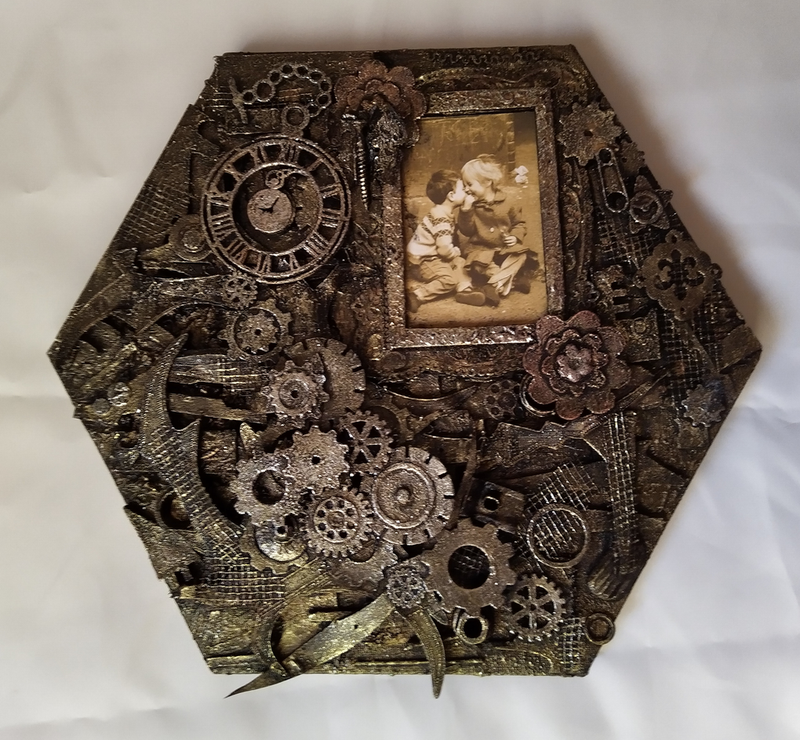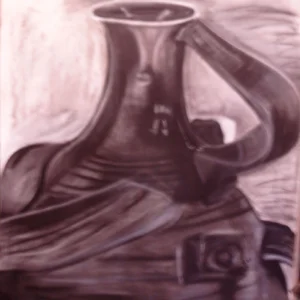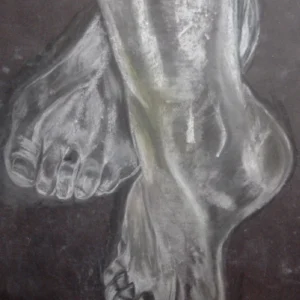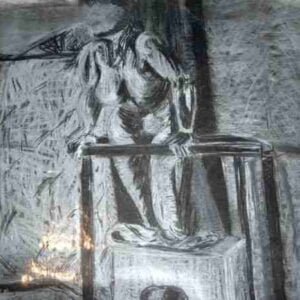A Moment in Time-1
A Mixed Media Exploration through A Moment in Time-1
In the shadowy quiet of an artist’s studio, where light plays an intimate game with darkness, a single canvas commands the room’s attention. It stands resolute, a presence both still and alive, wrapped in textures, hues, and layers that pulse with emotion. Titled A Moment in Time-1, this mixed media piece is more than a simple exploration of materials, it is a dialogue between the past and the present, between memory and emotion. It invites viewers to immerse themselves in an experience that transcends the visual, urging them to confront the transient nature of time and the stories it leaves behind.
From a distance, the canvas exudes a mystery, but as one approaches, the viewer is invited into a labyrinth of symbols, textures, and found objects, all of which challenge the boundaries between reality and recollection. A Moment in Time-1 is not just a piece of art, it is a portal into a journey, a moment frozen in time, where the mundane becomes sacred, and the chaos of the present merges with the nostalgia of the past.
The Power of the Clock, Time Captured
At the centre of the piece, a small but significant clock rests silently on the canvas. Its face, once crisp and clean, now appears worn and faded, a reflection of time itself. The hands are fixed at 9:05 p.m, frozen forever in that fleeting moment, neither advancing nor retreating. This stillness suggests the paradox of time, it is both relentless and yet always captured in specific moments. Here, the clock does not signify the passing of hours, but rather encapsulates a fragment of time, a single instance in an infinite continuum.
It’s a quiet defiance against the inevitable movement of hours, minutes, and seconds. In this captured moment, A Moment in Time-1 speaks to the suspended nature of memory, where certain instances become permanently etched in our consciousness, resistant to the passage of time.
The frozen hands of the clock serve as an anchor, offering viewers a point of reference in the otherwise tumultuous world of the canvas. Its frozen time echoes a moment we can all relate to, a moment when everything stands still. Whether it’s the memory of a child’s laughter, a fleeting glance shared with a lover, or the last moments spent with a loved one before they left, time is suspended in such instances. In A Moment in Time-1, the clock symbolizes the profound significance of these moments, frozen as if time itself acknowledges their importance.
The Photograph, A Glimpse into the Past
Beside the clock sits a weathered photograph, framed yet fragile, its sepia tones whispering of forgotten stories and long-gone eras. The photo, though fading with time, speaks volumes. It is the embodiment of nostalgia, a fragment of the past that refuses to be forgotten despite the erosion of its clarity.
Look closer, and a quiet moment unfolds: a little boy leans forward, his posture tentative yet bold, as if to steal a kiss from the girl beside him. Her expression is unreadable, caught between surprise and knowing, and just beneath the surface, a soft giggle escapes, a spontaneous burst of delight that captures the innocence of the moment. The scene, though simple, pulses with the purity of childhood and the timelessness of affection. It’s a gesture suspended in time, echoing the theme of the canvas itself, that even the smallest moments can carry the weight of memory. This fleeting act, captured in fading tones, becomes a symbol of vulnerability, curiosity, and the gentle ache of nostalgia.
The photograph is not merely a representation of people or places long gone, it is a symbol of the way we hold on to certain memories. The photograph within the canvas is as much a part of the viewer’s own narrative as it is part of the artwork itself. It might evoke memories of family gatherings, summers spent in faraway places, or forgotten faces that once held great importance. It draws the viewer into the mystery of a memory, inviting them to search their own history for a similar moment, to question what part of their past they have captured and held on to.
This fading photograph, sitting delicately beside the clock, amplifies the central theme of A Moment in Time-1, the interplay between memory and time. It serves as a metaphor for how memories, much like photographs, begin to deteriorate over time. Yet, like the clock’s frozen hands, these memories are precious because of their impermanence.
The Layers Tangible Textures of Memory
Beneath the photograph, the canvas reveals layers upon layers of textures, each piece of the composition an integral part of the whole. Torn pieces of paper, frayed edges of jointing tape, scattered plastic cogs, and other found objects cover the surface. These materials, seemingly random and chaotic, represent the detritus of our lives, the moments of disarray that we often try to ignore. However, in A Moment in Time-1, this chaos becomes meaningful. The rips and tears in the paper are not signs of destruction, but rather of history. They speak to the inevitable decay of all things, and yet, in this decay, there is beauty.
Each piece of the canvas tells its own story, fragments of a larger narrative. The ripped paper, for instance, might symbolize the pages of a forgotten diary or the tearing of bonds that once held strong. The plastic cogs are mechanical, man-made, yet they sit amidst the organic elements, evoking the passage of time in an industrial world. Each discarded object is imbued with significance, its presence within the artwork serving as a reminder of the objects and experiences we often overlook in the rush of everyday life.
The juxtaposition of natural and artificial components in A Moment in Time-1 invites viewers to question how time shapes our lives. What do we discard? What do we hold on to? What do we lose in the process of moving forward?
Organic Elements, The Unstoppable Passage of Nature
Interwoven within the detritus, organic components emerge. A tarnished screw sits beside a dried leaf, a symbol of nature’s continued cycle despite human endeavours. The screw, though corroded by time, still suggests a history, a purpose, and perhaps even a yearning to be revisited. The leaf, once alive and vibrant, now rests as a delicate fragment of the natural world. Together, they form a juxtaposition of decay and rebirth, of moments slipping away and yet continuing on, albeit in a different form.
In A Moment in Time-1, these organic elements serve as a meditation on the unstoppable passage of nature, which continues its course even when human-made moments are frozen in time. The screw and leaf are symbols of a broader truth, while memories and human experiences are fragile and fleeting, the natural world endures. It reminds us that, in the grand scheme of things, we are but temporary passengers on a much larger journey. The elements in the artwork, though fragmented and broken, evoke resilience, the quiet persistence of nature, the ongoing cycle of life and death, growth and decay.
Light and Shadow, The Dance of Memory
One of the most compelling aspects of A Moment in Time-1 is the way light interacts with the canvas. Light plays a pivotal role in shaping the viewer’s experience. As one steps closer, the shifting shadows of past moments dance over the canvas’s surface, creating an ephemeral connection between the artwork and the observer. These fleeting shadows transform the piece from a static object into a living entity. As light moves, it highlights and obscures different parts of the artwork, revealing new connections between the clock, the photograph, the objects, and the textures.
The delicate interplay of light and shadow in A Moment in Time-1 mirrors the way memory works. Just as light reveals certain details while concealing others, so too does our recollection of the past. Some memories remain sharp and clear, others become faint and elusive, shifting with the passage of time. This dynamic quality of the artwork forces the viewer to confront the inherent fluidity of memory. It challenges them to consider how the passage of time alters the way we perceive the past. What memories have been brought into focus by the light of the present? Which have been obscured by the shadows of time?
An Invitation to Reflect
A Moment in Time-1 is more than just a visual experience; it is an invitation to reflect on the fleeting nature of time and the memories that shape our lives. Through its mixed media composition, the piece encourages viewers to engage with their own personal narratives, to examine what moments have shaped them, and which moments they have allowed to slip away unnoticed. What is it that defines us? Is it the moments we hold tightly to, or those we let go of? The artwork encourages viewers to contemplate these questions, inviting them into a dialogue about what it means to live in time, to move through life, and to reflect on the moments that make up our existence.
The title itself, A Moment in Time-1, speaks to the singularity of the experience it encapsulates. It is not just one moment in a larger continuum but a moment that stands on its own, separate and unique. It asks the viewer to step into the artwork and experience that singularity. In the space between the clock’s frozen hands, the fading photograph, and the chaotic textures of the canvas, there is a sense of both continuity and disruption. There is both an invitation to embrace the flow of time and a recognition of the permanence of moments captured and held.
The Living Testament
As the viewer steps back from the canvas, the stillness of the clock’s frozen hands becomes a poignant reminder. The vibrancy of the chaotic layers surrounding it speaks to the complexity of life, while the stillness of the clock serves as a stark reminder that time, though constantly in motion, can also stand still. It prompts the viewer to reflect on the fleeting nature of life, to ask themselves what moments they will cherish next, and how they will move through the labyrinth of time.
In the end, A Moment in Time-1 is not simply an artwork, it is a living testament to the complexity of human experience. Through its mixed media elements, it invites us to recognize the impermanence of time while urging us to hold on to the moments that truly matter. Every moment, no matter how fleeting, leaves an indelible mark on the fabric of our lives. And as we look at the canvas, we are reminded that in the blink of an eye, another moment will pass, and another memory will be made. The question remains, What will that moment be? And what will we do with it?
Commission a Custom Art Piece
You can commission a bespoke mixed media artwork in your choice of colour (subject to availability), adding a personal touch that reflects your unique story and experiences. Each piece is thoughtfully crafted, ensuring that no two are ever the same, just like the moments they capture. This process fosters a meaningful connection between artist and patron, celebrating the individuality of each person’s journey through time.
Commissions Form
The more detail you provide, the better we can tailor the piece to your vision. Commissions typically take between 2 to 6 weeks to complete.
Thank you for looking
Please note, colours may vary from monitor to monitor.
Check out my other works here at https://lyn-5818.canvy.art/









Reviews
There are no reviews yet.